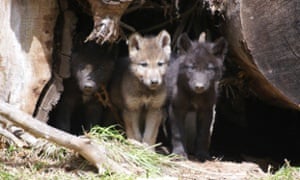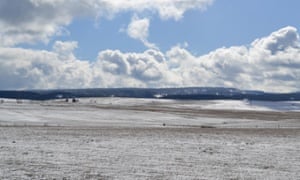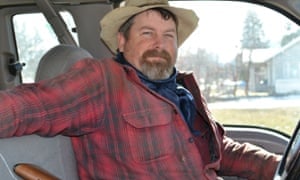As the state inches toward taking a species off the endangered list, it’s the humans who cannot seem to agree on how to deal with the growing population
Jason Wilson
Bumper stickers are one way to take the temperature of a culture war. On pickup trucks in Wallowa County, at the far north-eastern tip of Oregon, you’ll still see the slogans: “Wolves: smoke a pack a day”, “Canadian wolves: state sponsored terrorism”, and “SSS: shoot, shovel and shutup”. But the decals are often fading and peeling at the edges, or partially covered with newer enthusiasms.
There are still strong opinions on the predator’s return — nobody on any side of the argument is making easy concessions. But now that there have been more than four breeding pairs of wolves for two years running, the state has moved into Phase II of its wolf plan, and is inching towards taking the species off the endangered list. As this process moves along it may be taking some of the heat out of the wolf wars.
As little as two years ago, things were different. Last year, Rob and Emily Klavins bought a bed and breakfast just outside of the county seat of Enterprise. Like the couple who owned the business before him, they’re advocates of wolves and wildlife in general. But so far, he says, there’s no indication that he’ll have the problems the Hunters did.

It was statewide news in 2013 when anger over their predecessors hosting “wolf-watchers” spilled over into a local planning dispute. Ranchers objected to them expanding their business to new premises adjoining ranches on the “wolf highway” where wolves and stock mingle. They had to promise not to “call wolves” to the area.
Amid the acrimony, their proposal for a new B&B was rejected. The hunters eventually quit the county. Back then, being pro-wolf could mean ostracism and ruin. At the zenith of a culture war, there’s seldom room for compromise.
Since the Klavins arrived, though, Rob says that not everyone might be happy for him to be here, “there’s been nothing open, nothing said to my face.” There may be the odd glare in downtown Enterprise, but they can’t be sure they’re not seeing them because they’re looking for them. It resembles a truce, albeit an uneasy one.
That’s all the more remarkable when you know that Rob’s main gig is as the regional field coordinator for Oregon Wild, the state’s most prominent wildlife NGO. They’re about as popular with the anti-wolf crowd as the wolves are. Hostility has played out in the courts.
From 2010, Oregon Wild and three other groups took legal action to prevent the extermination of wolves from the Imnaha Pack. Several cattle had been taken by the pack, and the Oregon Department of Fish and Wildlife (ODFW), which administers the state’s wolf plan, authorised the removal of two wolves for “chronic depredation”.

The environmentalists argued that ODFW was breaking state laws, and its own rules. In the settlement in 2013 — itself the product of grueling negotiations — the agency had to clarify the steps necessary before a wolf could be killed. Though The Oregon Cattlemen’s Association had been party to the discussions, they were furious about the outcome, saying that the new definition of chronic depredation was impossible to meet.
Where the cattlemen go, many Wallowans will follow. Between the angry public meetings, local campaigns, and national media attention, a lot of local supporters of the wolves elected to keep their views to themselves.
Reviving an endangered species
In 2010, when the legal action commenced, Oregon had just 14 wolves. In 2008, there were none. They were reintroduced to Idaho from Canada under Federal tutelage in 1995, in an attempt to revive an endangered species that was extinct in most of the American west. From there they dispersed throughout the wilderness of the Pacific Northwest’s interior that, like them, respects no borders.
Two decades later, they reintroduced themselves to Oregon. Wallowa’s were the first Oregonian wolves in more than half a century. The last of the original population was shot in 1947, near Crater Lake, for a $5 bounty.
Having being systematically extirpated, they have bounced back quickly. ”People used to think they were a really fragile species”, says Klavins, “but if we just don’t shoot them, they will recover”. Now there are 77 confirmed to be living in Oregon, and almost certainly more. Fifty of those counted spend at least some of their time in Wallowa County.

For the wolves the place has a lot to offer. It’s isolated, sparsely populated, and teeming with game. There’s just over 3,000 square miles of land, but only 7,000 people. Almost all of them live along along Highway 82, which runs south-east through the Wallowa Valley, and connects the main towns of Enterprise, Joseph, and Lostine with the tourist magnet of Wallowa Lake.
This settled strip is surrounded by a diverse, spectacular wilderness, much of which is protected. In the south and west are the Wallowa Mountains, whose peaks dominate the landscape. In the far east is the arid, depressed country leading down Hell’s Canyon, which bottoms out at the Snake River, which the wolves crossed when they moved from Idaho, and which they now treat more as a crosswalk than a barrier.
And in the centre is the county’s jewel, the Zumwalt, one of the few Western prairies that was never wholly plowed. This grassy plain is well stocked with all kinds of wildlife, including the Rocky Mountain Elk and Black-tailed deer that are the wolves’ main sources of food.
But the Prairie is contested ground. It is also home, at least some of the time, to many of the 35,000-odd cattle who graze in the county. There’s no question that wolves have eaten them from time to time — there were two confirmed kills here in 2014 — and though cattle depredation is decreasing, there’s no question that it will happen again in the future.
Ranchers ‘wish they weren’t here’
Todd Nash finds all of that difficult to accept. “I wish they weren’t here”. Nash has lived here since he was five. He had two years and college, but for the remainder of his adult life he’s been a rancher. He’s the local spokesman of the Oregon Cattleman’s Association, and he’s passionate about the ranchers’ rights to protect their interests.

In a field at the foot of the range, his ruddy face crinkles with disgust under his battered bush hat as he describes what wolf depredation on calves looks like. “They eat everything, even the hide. Then they scatter the bones.” He talks about one calf that was taken by the Imnahas, where the next morning “all that was left was one hoof”.
Like many in eastern Oregon, he’s resentful about the political dominance of the populous “westside”, the name they give to Portland, Salem, and all parts west of the Cascade Mountains. People there don’t understand the bond between between ranchers and their herds. “We are out here in the middle of the night helping cows give birth.” It’s a relationship of care. Nash can’t bear that ranchers are stereotyped as “wolf-haters” when he’s seen men “literally crying when they see what wolves have done to their cattle”.
Playing politics
Ranchers feel perennially disrespected, and suspect that process and policy has been rigged by Democrat governors and state Houses. It rankles that ODFW won’t release the precise location of GPS-collared wolves. “You’re accused of wanting to use it to go and kill a wolf. But we want to protect our livestock, and we want to be effective at it.”
He says that what he really wants is to be able to direct range riders to wolves, so they can be driven off. He tells me about ranchers in Washington state, where exact locations are given out, being able to drive wolves off “without shooting them”. (Wolf advocates worry that making this information public would lead to a free-for-all on wolf poaching).
Another complaint involves money. The state distributes compensation to ranchers for confirmed depredations. The determination on whether a wolf is guilty is made by ODFW and only given to ranchers who have non-lethal preventative measures in place.

Nash says compensation is a “great tool to pay guys who’ve had tremendous loss, but it’s a band-aid”. First, he thinks that ODFW have made wolf depredation too hard to prove. But he says that ranchers suffer in ways that the current system doesn’t even touch. He cites above average losses in circumstances where they can’t prove wolf kills. He says the stress of interacting with wolves means that cattle don’t reach the weights that they used to. And there’s no doubt that non-lethal measures (mainly involving extra vigilance and the deployment of fladdery tape) mean a lot of extra work for ranchers. In effect, Nash thinks they’re are being asked to bear a cost that no one is even interested in accurately measuring.
For all this, he didn’t advocate eradicating wolves altogether, and stressed his desire to chase wolves away where possible, rather than killing them. There’s no doubt that Nash wants wolves who habitually prey on cattle to be taken out. But everyone I talked to, on either side, agrees with that general point. The disagreement is all about thresholds, what counts as predation, which wolves should be targeted when a pack is killing cattle, and who has the right to pull the trigger.
Neither did he mention the other big talking point that I heard in bars around the county from people who dislike the return of wolves — these are “Canadian wolves”, bigger and more aggressive than the native species, which don’t belong here.
ODFW wolf biologist Russ Morgan, who assesses wolf depredations, says he used to hear that all the time, but no one’s put it to him much lately. Perhaps because they know he doesn’t have a great deal of time for the idea. “Taxonomy is not an exact science” he says, but the argument about differing sub-species is a red herring. There may be a marginal difference in size compared to those here before, but “so what? Behaviourally it’s the same animal.”
John Stephenson, a biologist from the US Fish and Wildlife Service’s Oregon office, agrees. “It’s not like those original Oregon wolves were eating berries. The ranchers were killing them for a reason.”

Joe Whittle, a photographer who calls the region his home, told a story about how, long ago, wolves and berries used to go together.
Kindred spirits
Joe is Native American, though descended from Caddo and Delaware people, and not a member of the local Nez Perce tribe. His father moved here and he has lived here his whole life. The Wallowa branch of the Nez Perce, led by the legendary Chief Joseph, were driven from Wallowa County into Idaho by force in 1877. Their reservation is now just over the Idaho border. Even now, there are very few Nez Perce people living in the county.
He stresses that he can’t speak for the Nez Perce people, but he is able to share some stories. Up in the divide country between the Wallowas and the Snake River, he recalls what a local Nez Perce elder, Horace Axtell, said to him. Axtell’s own grandmother, who was alive in the late 19th century, when her people were still living in Wallowa, told him about the cooperation between the Nez Perce and the wolves, which they viewed as kindred spirits.
In huckleberry season, wolves would alert Indians to the presence of game. When the Indians killed it they would leave gut piles and scraps for the wolves as an offering. Altogether it was a mutually beneficial exchange: the Nez Perce got game, the wolves got a risk-free meal. Unlike later white settlers, the Nez Perce never felt “at war” with the landscape, and “they never felt the need to wipe out every wolf and Indian”.
Like every wolf advocate I talked with, Whittle believes that ranchers have a right to protect their stock. But he points out that ranchers are not the only ones who face challenges making a living in Wallowa County. He’s a freelance photographer and a wilderness guide, but in between he’s done “every odd job in the county”.
“I don’t require the eradication of any native species to pursue my ideal means of living on this land. I am not against subsidies, or the right to use lethal force to protect livestock, but I don’t believe anyone has the right to wipe out an entire species in the name of profit. Doing that here and everywhere else in the west was wrong.” He points out that the Nez Perce were themselves pastoralists by the time they were evicted, keeping their herds alongside the wolves.

Joe laughs a lot, not least when asked why he thinks that the ranchers’ attitude to wolves is so different. “There’s a whole mindset which is a result of Manifest Destiny and colonialism: ‘we gotta conquer this land, take what we need out of it and move on to the next thing.’” Settlers were focussed on surviving in an unfamiliar environment. Instead, “we need to think about thriving”.
He doesn’t think attitudes will change quickly, but recently he’s seen the emergence of rough, uneasy compromise. He points to the 40-year trickle of hippies, misfits and sculptors over the years into Joseph, which now resembles an artists colony, with nine bronze foundries and a Main Street full of galleries. “Different groups of people have learned how to work things out in this county.”
The impression is that the politics of wolves have shifted from the basic questions of their right to exist in this landscape. In the Hydrant bar, on Karaoke night, a cowboy a few drinks in to his evening told me that “the bastards should be wiped out”, but sober people no longer seem to say that out loud. They may still think it, but in a practical sense they’ve moved on, however difficult they may find it to admit that.
Conversations now are about the pragmatic matters of compensation, subsidy, and the limits of livestock protection. You can shoot wolves pretty freely over the border, but blue-state Oregon isn’t Idaho, and never will be. Ranchers might resent the political dominance of the westside, but they have had a lot of practice living with it. For their part, wolf advocates know that it’s still the American west: no predator will ever have carte blanche.
There will likely always be attempts to redraw these lines in one direction or another, and no one may ultimately agree about the value of wolves, but thanks to a lot of hard work and difficult conversations, extermination is likely off the table forever. If the guys with bumper stickers ever poach a wolf, it’s not making much of a dint in their recovery. The wolves are here to stay.
In political philosophy, modus vivendi describes an arrangement where we give up on idle dreams of consensus, agree to disagree, and find ways to live alongside one another despite our fundamentally opposed values. Historically speaking it’s a tricky business, but Wallowa County seems to be slowly learning how to pull it off. As wolves become more established in the western half of the state, and even venture into California, other communities will need to understand how they did it.
Meanwhile, on the mountainsides, down in the canyons, and in the long grass of the Zumwalt, the wolves are waiting patiently for humans to rearrange their affairs around them.
